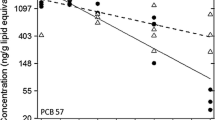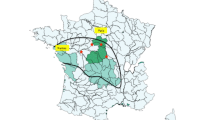Abstract
Levels of polychlorinated biphenyls, PCBs, in liver samples of 111 and 121 flounder (Platichthys flesus L.) and cod (Gadus morhua L.), respectively, were determined gas chromatographically by quantification of 9 individual PCB congeners. The congeners were 28, 52, 101, 118, 153, 138, 180, 170, and 209 (IUPAC numbering system, Ballschmiter and Zell 1980). The fish were caught during 1988 at 5 different stations near or in the Glomma estuary, in the Hvaler archipelago, Norway. The mean level of the sum of the congeners, 1,050 ng/g, found in cod was 3 times higher than the corresponding level found in flounder (361 ng/g). The influences on the variation in PCB levels of sex, season, and distance from the Glomma outlet and waterway were investigated using 1-, 2-, and 3-way ANOVA. The main effects of these factors as well as their possible interactions were considered. An expected decreasing PCB pollution gradient from the mouth of Glomma was found for cod, while PCB levels in flounder seemed to be less dependent on sampling site. However, the sexes in both fish species exhibited a different pattern in their PCB levels. The PCB levels in female cod were significantly affected by the season of sampling, with PCB levels in September/October significantly greater than the corresponding levels in June and November/December. No such effect was found for male cod. In flounder, a significant station effect on the PCB levels was found for females only, and a decreasing PCB pollution gradient was found to be significant. The interactions between the three factors station, season, and sex were different in the two species. There was an interaction between sex and season in cod while in flounder the sex interacted with station. These interaction phenomena require further analysis, since no general procedure exists for analyzing interactions when a biological interpretation is at issue.
Similar content being viewed by others
References
Ballschmiter K, Zell M (1980) Analysis of polychiorinated biphenyis (PCB) by glass capillary gas chromatography. Fresenius Z Anal Chem. 302:20–31
Brevik EM (1978) Gas Chromatographic method for the determination of organochlorine pesticides in human milk. Bull Environ Contam Toxicol 19:281–286
Bruggeman WA (1982) Hydrophobic interactions in the aquatic environment. In: The Book of Environmental Chemistry. Vol. 2B, 83–102
Carlberg GE, Martinsen K, Kringstad A, Gjessing E, Grande M, Kallquist T, Skaare JU (1986) Influence of aquatic humus on the bioavailability of chlorinated micropollutants in Atlantic salmon. Arch Environ Contam Toxicol 15:543–548
Christensen JM (1964) Burning of otoliths, a technique for age determination of soles and other fish. Conseil Permanent International Pour L'Exploration de la Mer. J Conseil. 29(1):73–81
Clark RB (1986) Marine Pollution. Clarendon Press, Oxford, 215 pp
Collier TK (1988) Xenobiotic metabolizing enzymes in liver of flatfish from Pudget Sound, Washington, Doctor of Philosophy, University of Washington, 110 pp
Dawson AS, Grimm AS (1980) Quantitative seasonal changes in the protein, lipid and energy content of the carcass, ovaries and liver of adult female plaice,Pleuronectes platessa L. J Fish Biol 16:493–504
De Boer J (1988) Trends in chlorobiphenyl contents in livers of atlantic cod (Gadus morhua) from the North Sea, 1979–1987. Chemosphere 17(9): 1811–1819
Förlin LT, Andersson U, Koivusaari, Hanson T (1984) Influence of biological and environmental factors on hepatic steroid and xenobiotic metabolism in fish-interaction with PCB and β-naphtoflavone. Marine Environ Res 14:48–58
Freeman HC, Uthe JF, Silk TJ (1984) Polychiorinated biphenyis, organochlorine pesticides and chlorobenzenes content of livers from Atlantic cod (Gadus morhua) caught off Halifax, Nova Scotia. Environ Monit Assessment 4:389–394
Hansen PD, Westernhagen HD, Rosenthal H (1985) Chlorinated hydrocarbons and hatching success in Baltic herring spring spawners. Marine Environ Res 15:59–76
Ingebrigtsen K, Skaare JU, Teigen SW (1984) Organochlorine residues in two Norwegian puffin (Fratercula artica) colonies. JToxicol Environ Health 14:813–824
Ingebrigtsen K, Solbakken JE (1985) Distribution and elimination of (C-14) hexaclorobenzene after single oral exposure in cod (Gadus morhua) and flounder (Platichthys flesus). J Toxicol Environ Health 16:197–205
Knutzen J (1984) Basisundersøkelser i Hvalerområdet og Singlfejorden. Miljøgifter i organismer 1980–1981. Norwegian Institute of Water Research. Report 122/84
- (1987) On “background levels” of organochlorines in fish. Norwegian Institute of Waterresearch. Report 0-85167
Larsen RJ, Marx ML (1986) An introduction to mathematical statistics and its applications. Prentice-Hall International. Inc. New Jersey. 625 pp
Lindman HR (1974) Analysis of variance in complex experimental designs. Freeman & Co, San Francisco, 325 pp
Monfelt C, Lindestrøm L (1989) Undersøkninger av skrubbskadda (Platichthys flesus L) fangad i Hvaler-ock Singlefjordsområdet høsten 1988. Svenska Miljøforskargruppen, Sweden, AB F91037
Sawyer (1978) Quantitation of polychlorinated biphenyl residues by electron capture gas-liquid chromatography, reference material characterization and preliminary study. J Assoc Offic Anal Chem 60(2):272–281
Scheffe H (1959) The analysis of variance, John Wiley, New York, 477 pp
Skaare JU, Stenersen J, Kveseth N, Polder A (1985) Time trends of organochlorine chemical residues in seven sedentary marine fish species from a Norwegian fjord during the period 1972–1982. Arch Environ Contain Toxicol 14:33–41
Skaare JU, Tuveng JM, Sande HA (1988) Organochlorine pesticides and polychlorinated biphenyls in maternal adipose tissue, blood, milk and cord blood from mothers and their infants living in Norway. Arch Environ Contam Toxicol 17:55–63
Skaare JU, Markussen NH, Nordheim G, Haugen S (1990) Polychlorinated biphenyls, organochlorine pesticides, and heavy metals in the harbour seal (Phoca vitulina) in Norwegian waters. In press.
Bakken JE, Ingebrigtsen K, Palmork KH (1984) Comparative study on the fate of the polychlorinated biphenyls 2, 4, 5, 2′, 4′, 5′-hexachlorobiphenyl and polycyclic aromatic hydrocarbon phenanthrene in flounder (Platichthys flesus) determined by liquid scintillation counting and autoradiography. Marine Biol 83:239–246
Spies RB, Rice DW, Felton J (1988) Effects of organic contaminants on reproduction of the starry flounderPlatichthys stellatus in San Francisco Bay. Marine Biol 98:181–189
Tarlebo J (1984) Variasjoner i enzymsystemet “mixed function oxidase” i skrubbe,Platichthys flesus, L. Kan dette systemet brukes som en biologisk indikator pa marin forurensing? Cand scient Thesis, University of Bergen, Norway, 129 pp
Ten Berge WF, Hillebrand M (1974) Organochlorine compounds in several marine organisms from the North Sea and the Dutch Wadden Sea. Netherlands J Sea Research. 8(4):361–368
Westernhagen HV, Cameron P, Dethlefsen V, Janssen D (1989) Chlorinated hydrocarbons in North Sea whiting (Merlangius merlangus L.), and effects on reproduction. I. Tissue burden and hatching success. Helgoländer Meeresuntersuch 43:45–60
Wildish DJ, Metcalfe CD, Akagi HM, McLeese DW (1980) Flux of Aroclor 1254 between estuarine sediments and water. Bull Environ Contam Toxicol 24:20–26
Williams T, Bedford BC (1974) The use of otoliths for age determination. In: Bagenal TB (ed) Ageing of fish. Unwin Brothers Limited, England, 234 pp
Author information
Authors and Affiliations
Rights and permissions
About this article
Cite this article
Marthinsen, I., Staveland, G., Skaare, J.U. et al. Levels of environmental pollutants in male and female flounder (Platichthys flesus L.) and cod (Gadus morhua L.) caught during the year 1988 near or in the waterway of Glomma, the largest river of Norway. I. Polychlorinated biphenyls. Arch. Environ. Contam. Toxicol. 20, 353–360 (1991). https://doi.org/10.1007/BF01064402
Received:
Revised:
Issue Date:
DOI: https://doi.org/10.1007/BF01064402




